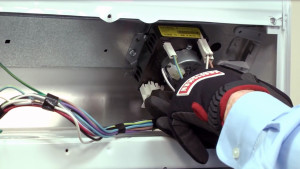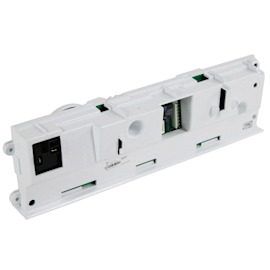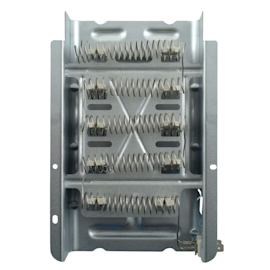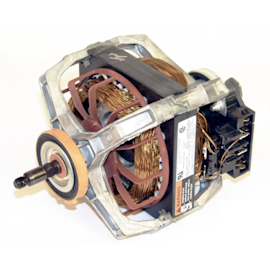Electric dryer won't heat troubleshooting video


These troubleshooting tips are for an electric dryer not heating. If you have a gas dryer, see our Gas dryer won't heat troubleshooting video.
A dryer that won’t heat can keep both your clothes and your mood damp. In this Sears PartsDirect video, we troubleshoot why your dryer won’t heat, including checking the heating element, high-limit thermostat, operating thermostat, thermal cut-off fuse and timer. Learn about a few easy tests you can run to find the problem, including using a multimeter to make sure current is flowing between the parts. Once you know what the issue is, follow our step-by-step guides to fix your dryer—and brighten your spirits.
Check out our DIY dryer repair help page for additional videos, repair guides and articles.
Tools and parts needed
Screwdriver
Multimeter
Work gloves
Hi, this is Wayne from Sears PartsDirect. Today we’re going to talk about troubleshooting an electric dryer that won’t heat. There are a few things that could keep your dryer from heating. You might have a problem with the power supply to the dryer, a broken heating element, high-limit thermostat, operating thermostat, thermal cut-off fuse or timer.
I know that sounds like a lot, but don’t worry, we’ll help you work through them.
Check power supply to dryer
The first step is to check to see if the dryer is getting the correct amount of power. You may think the dryer is getting enough power if the motor runs, but the heating element needs 240 volts of electricity to heat. The motor will run even if the dryer is only getting 120 volts of power.
Check your power cord to make sure it’s not damaged. Then, reset your house circuit breaker to make sure it’s not tripped. Set your dryer to a timed dry, high-heat cycle and see if it heats up after resetting the breakers.
If it’s still not heating, we’ll need to check the components on the control circuit. Checking continuity with a multimeter will allow us to test them all at once.
First, unplug the dryer. For safety, always disconnect power before checking continuity. Remove the back panel from the dryer, then remove the back of the control panel. Unplug the large red wire from terminal "A" on the timer. Set the multimeter to read ohms of resistance.
Measure resistance between the large red wire on the timer and the heating element terminal where the large red wire is connected. If you measure near 15 ohms of resistance through this circuit, then you know that the heating element, high-limit thermostat, operating thermostat and thermal cut-off fuse are all okay. You can skip ahead to learn how to check out your timer.
Make sure heating element works
If you measured no electrical continuity through this circuit, which is an "OL" on this multimeter, then we’ll check the heating element. Place your meter leads on the heating element terminals. You should measure near 15 ohms of resistance through the heating element.
If you measured no continuity, then the heating element is broken. This video will show you how to replace it. If you measured near 15 ohms of resistance, then the heating element is good.
Check high-limit thermostat
We’ll check the high-limit thermostat next. Place one meter lead on each terminal of the high-limit thermostat. You should measure near 0 ohms. If you measured no continuity, then the high-limit thermostat will need to be replaced.
Test operating thermostat
If your high-limit thermostat is okay, we’ll check the operating thermostat next. Place one meter lead on the red wire and the other meter lead on the red-white wire. You should measure near 0 ohms of resistance through the operating thermostat. If you measured no continuity, the operating thermostat will need to be replaced.
Did thermal cut-off fuse fail?
If your operating thermostat is good, we’ll check the thermal cut-off fuse next. Place one meter lead on the red-white wire and the other on the red wire. You should measure near 0 ohms. If you measured no continuity, you’ll need to replace the thermal cut-off fuse.
Check timer last
If the thermal cut-off fuse is good, we’ll check the timer last. With the dryer still disconnected, turn the timer to timed dry, high heat. Place one meter lead on terminal "A" with the red wire and the other on terminal "C" with the black wire. If you measured no continuity, then the timer is broken.
Here’s a video that will show you how to replace it.
Other possible problems
If you’ve made it through all these checks and you still haven’t found your problem, you could have a defective motor centrifugal switch, a bad plug or a failed circuit breaker. You'll need to get a service technician to check these for you.
Hey, thanks for watching. Check out our other repair videos here on the YouTube channel, and if you like them, subscribe.
This video shows troubleshooting tips on a Kenmore dryer not heating. These tips can also help you troubleshoot Whirlpool, Amana, Maytag, Frigidaire and GE electric dryers that aren't heating.
Most common symptoms to help you fix your dryers
Choose a symptom to see related dryer repairs.
Main causes: bad gas valve coils, broken heating element, tripped safety thermostat or fuse, bad operating thermostat, c…
Main causes: bad drum support roller, damaged idler pulley, broken blower fan blade, worn drum glide bearing, bad drive …
Main causes: damaged door strike, worn door catch…
Main causes: clogged exhaust vent, bad motor relay, loose dryer door catch, bad door switch, control system failure, fau…
Main causes: door switch failure, lack of power, broken belt, blown thermal fuse, bad drive motor, control system failur…
Main causes: clogged exhaust system, heating system failure, deposits on moisture sensor, control system failure…
Main causes: bad timer or electronic control board, door switch failure…
Main causes: lack of electrical power, bad power cord, wiring failure, bad control board, blown thermal fuse, bad door s…
Most common repair guides to help fix your dryers
These step-by-step repair guides will help you safely fix what’s broken on your dryer.

How to replace an electronic control board in an electric dryer
The electronic control board manages the components and controls the cycle times in your electric dryer. Follow these st…

How to replace a heating element in an electric dryer
The heating element in an electric dryer generates the dryer's heat—it's one of the first things to check if the air in …

How to replace a dryer drive motor
A defective drive motor struggles to rotate the drum or might not turn the drum at all. Follow the steps in this dryer r…
Effective articles & videos to help repair your dryers
Use the advice and tips in these articles and videos to get the most out of your dryer.

Get expert tips on using your dryer efficiently to save energy.…

Learn about all the convenient features on our Sears PartsDirect website that make your parts purchases easier.…

Get answers to frequently asked questions about Sears and Sears PartsDirect.…
